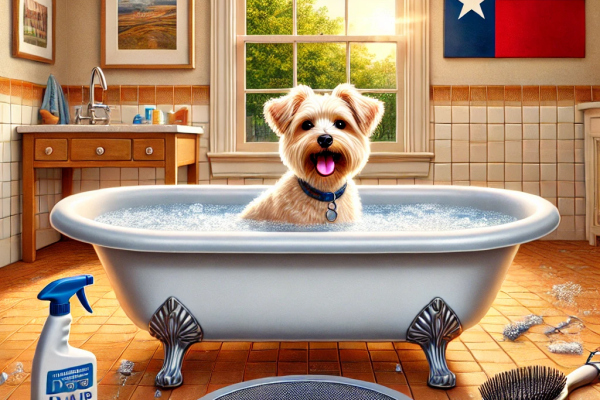
Texas Tips: How to Keep Dog Hair Out of Your Drains and Maintain a Clean Bathtub
Introduction
Bathing your pets is an essential part of their care, especially in the hot and humid climate of Texas. However, for dog owners, it can become a real challenge for your plumbing. The intense Texas heat promotes active shedding, and the variety of breeds, from long-haired to short-haired, leads to regular accumulation of fur in the drains. According to studies, up to 70% of dog owners encounter drain clogs caused by pet hair. How can you prevent your pipes from getting clogged and keep your bathtub clean? In this article, we’ll share proven Texas hacks that will help you tackle this problem effectively and without unnecessary expenses.
Why Dog Hair Clogs Drains
Every pet owner knows how satisfying it is to see a clean and well-groomed dog after a bath. However, even with meticulous care, hair can end up in the drains and cause clogs. This is especially true for owners of long-haired breeds like Yorkshire Terriers, but short-haired dogs are not immune to this problem either. In Texas, where many pet owners spend time outdoors, maintaining your plumbing becomes even more crucial. Clogs not only create inconveniences but can also lead to costly repairs.
Two Simple Ways to Prevent Your Drains from Getting Clogged with Dog Hair
Regular Brushing Before Bathing
One of the most effective ways to reduce the amount of hair that ends up in the drain is to regularly brush your pet before bathing. In Texas, where the heat encourages active shedding, it is recommended to brush your dog at least once a day. Even short-haired breeds shed hair that can get trapped in the undercoat and cause clogs when exposed to water and soap.
Benefits of Brushing:
- Reduces the amount of shedding hair.
- Prevents matting, which decreases the need for frequent baths.
- Promotes healthy skin and coat, preventing irritation and infections.
Tip from Texas Specialists: Use high-quality brushes and combs suitable for your breed. On hot days, add moisturizing products to keep the fur soft and easier to brush. Consider using special anti-static brushes that help retain hair during brushing.
Using a Bathtub Plug
Even a simple bathtub plug can significantly reduce the amount of hair that enters the drain. In Texas homes, where it can be hot and humid, handling the aftermath of pet baths quickly and efficiently is essential.
Types of Plugs:
- Traditional bathtub stoppers.
- Towels or rags as temporary measures.
- Plastic bags filled with water to create a tight seal.
Professional Tip: For regular use, consider investing in specialized hair catchers or mesh screens that allow water to flow through while trapping hair. These are particularly useful in Texas, where frequent use of plumbing systems can lead to rapid clogs.
Additional Recommendations for Texas Dog Owners
Invest in Specialized Bathing Accessories
In Texas, where many pet owners bathe their pets outdoors or in specially equipped tubs, having the right tools is essential. Consider purchasing portable shower systems or specialized dog tubs that minimize the amount of hair entering the drain.
Regular Drain Cleaning
Even with all preventive measures, clogs can still occur occasionally. Regular drain cleaning helps prevent the buildup of hair and other debris. Use simple methods like a plunger or a mixture of baking soda and vinegar to keep your pipes clean.
Choose the Right Washing Products
Use shampoos and conditioners specifically designed to reduce shedding. These products not only make coat maintenance easier but also help minimize the amount of hair that ends up in the drain. In Texas, where temperatures can be high, using cooling shampoos also helps keep your pet comfortable during baths.
How to Clean Pet Hair from the Tub Drain
Using a Plunger
For minor clogs, a plunger can be an effective tool. Press down on the clog several times to create pressure that helps loosen accumulated hair and other debris. Regular use of a plunger helps maintain clean drains.
Baking Soda and Vinegar Mixture
If the plunger doesn't work, try using natural cleaning agents. Pour a cup of baking soda into the drain, followed by a cup of vinegar. Let the mixture sit for 5-10 minutes, then rinse with hot water. This reaction helps break down the clog and remove accumulated hair.
Using a Plumbing Snake
For more stubborn clogs, a plumbing snake is the tool of choice. This flexible tool allows you to reach deep into the pipes and remove accumulated hair and other obstructions.
Using a Vacuum Drain Cleaner
Modern vacuum drain cleaners effectively remove clogs without damaging pipes. These devices are particularly useful in Texas, where high temperatures can accelerate clog formation.
Why Not Use Chemical Cleaners to Dissolve Pet Hair
While there are many chemical drain cleaners available, they can be harmful to your pipes and the environment. In Texas, where environmental conditions demand careful water management, natural cleaning methods are more desirable. Moreover, chemical cleaners often prove less effective on severe clogs and can lead to pipe damage.
Benefits of Natural Cleaning Methods:
Using baking soda and vinegar safely protects your pipes and the environment while effectively eliminating clogs caused by hair and other organic materials. These natural agents are ideal for pet owners who care about their pets' health and their home's cleanliness.
Conclusion
Maintaining a clean bathtub and drains after bathing your dog is an important task for every pet owner, especially in Texas. Regular brushing, using plugs, and investing in specialized accessories help prevent pipe clogs and keep your plumbing in excellent condition. In case a clog occurs, use natural cleaning methods or contact professionals like the specialists at Benjamin Franklin Plumbing. Prevention is always better than cure, and regular care for both your pet and your plumbing will help you avoid problems and keep your home clean and comfortable.
Additional Resources
For those looking to learn more about proper pet care and maintaining a clean home, explore our other articles and guides. Subscribe to our newsletter for regular updates and tips from pet care experts and plumbers.






